As integral to human life as language, art has accompanied human life for tens of thousands of years, and it has only grown in its uniqueness & character over that time. From the great ziggurats of Mesopotamia, to the sculptures of the classical period and the great gothic cathedrals of western europe, physical art has been the one of the most effective ways of conveying messages throughout human history. Just like language and story, art has a history to it, styles & motifs that tell narratives, each of which is unique to the culture & history of the people who designed them. Even today, styles reflect the narratives we wish to share, and the values that our cultures hold. These styles also hold history in it of itself, cultural ideals, traditions, and unconscious values designed by the ancients that affect us to this day. This exhibition seeks to share how art helps us understand the ancients that came before us, the narratives they sought to portray, and how said narratives have affected our modern outlook, especially the effects on westerners through the complex history of Europe. Through this, we can better understand what those in the past thought, the stories they sought to tell, and we can better see that we are not so different from those who lived hundreds to thousands of years in the past.
Don't wanna be here? Send us removal request.
Text
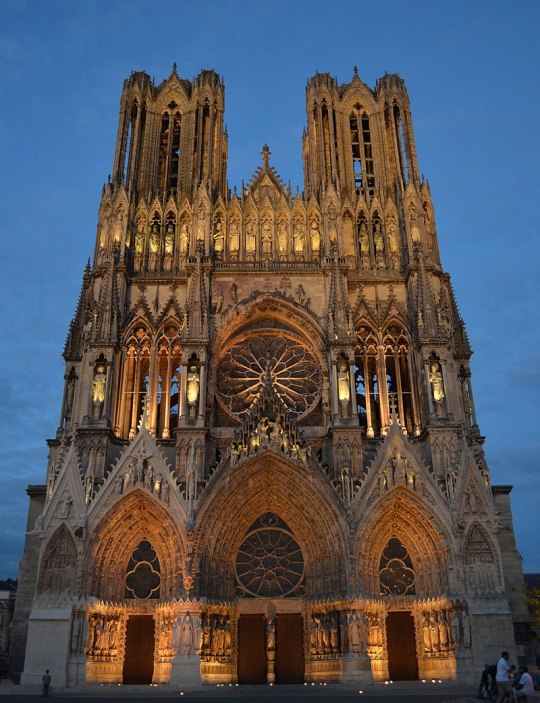
Jean d’Orbais, Jean le Loup, Gaucher de Reims, and Bernard de Soissons West Facade of Reims Cathedral 1211–1290 Stone Dimensions variable Reims Cathedral, Reims, France
The Reims Cathedral, designed by Jean d’Orbais, Jean le Loup, Gaucher de Reims, and Bernard de Soissons is a Gothic masterpiece featuring intricate sculptures of the Virgin Mary, Christ, and saints, with an emphasis on naturalism and verticality. The grand rose window and three portals highlight light and space, aiming to inspire awe and evoke a sense of divine presence. This cathedral took decades to construct, and so is also a symbol of the community & heritage of the people who dwell in Reims to this day. To us today, the facade is celebrated for its architectural brilliance and as a symbol of medieval devotion, influencing Western architecture and continuing to inspire admiration for its technical and artistic achievements.
0 notes
Text
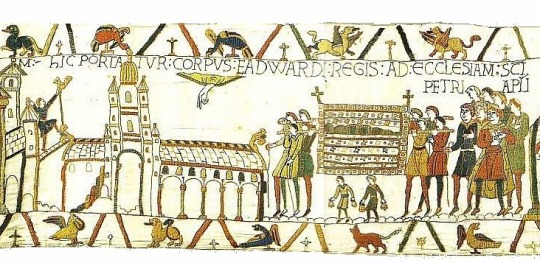
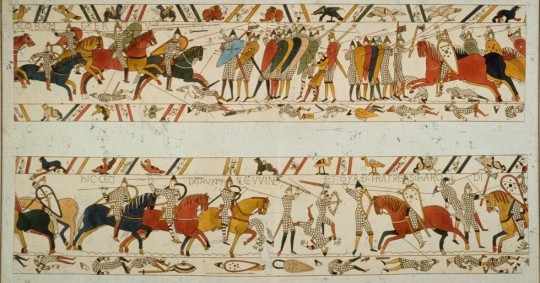
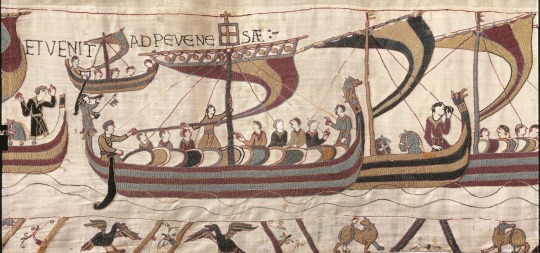
Unknown Scenes from the Bayeux Tapestry 1070–1080 Embroidered wool on linen 229' 8" long Bayeux Cathedral, Bayeux, France
The Bayeux Tapestry depicts the events leading up to and following the Norman Conquest of England in 1066, including key moments like the Battle of Hastings and the death of King Harold. The tapestry combines historical storytelling with artistic detail, emphasizing the drama and significance of these events to the history of France & England both. Like the Lindisfarne Gospels, this tapestry gives us another glimpse into the developing English identity, a culture which has influenced many peoples across the world. In the modern world, it is valued not only as a unique historical document but also as an early form of visual storytelling, inspiring contemporary graphic narratives and highlighting art’s power to communicate history.
0 notes
Text
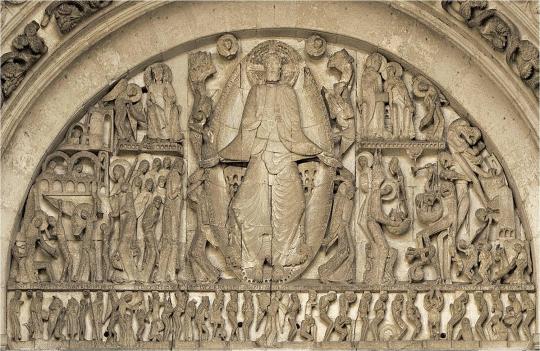
Gislebertus Last Judgment (West Tympanum) 1120–1135 Marble 21' Wide at Base Saint-Lazare, Autun, France
The Last Judgment tympanum by Gislebertus is a striking Romanesque sculpture depicting Christ’s final judgment, with angels and demons sorting the saved from the damned. The expressive, exaggerated figures emphasize the dramatic contrast between salvation & damnation. This vivid imagery was meant to convey spiritual truths to a largely illiterate audience. In the modern world, the tympanum reminds us of art’s power to evoke deep emotional responses and communicate universal themes of justice, redemption, and the human condition.
0 notes
Text

Unknown Old Testament Prophet (Jeremiah or Isaiah?) (Right side of the trumeau of the south portal, Saint-Pierre, Moissac, France) 1115–1130 Stone Unknown Saint-Pierre, Moissac, France
The Old Testament Prophet (likely Jeremiah or Isaiah) exemplifies Romanesque sculpture with its elongated form, intricate drapery, and scroll symbolizing the prophet’s divine message. Positioned at the portal, it connects the Old and New Testaments, highlighting the prophet's role in foreshadowing Christ. The expressive, stylized figure reflects the Romanesque focus on conveying spiritual meaning over naturalism. In the modern world, this work resonates with the enduring ability of art to help communicate deep truths and the continuing relevance of prophetic voices advocating for justice and wisdom.
1 note
·
View note
Text

Bishop Bernward Doors with Relief Panels (Genesis: left door; Life of Christ: right door) 1015 Bronze 15' 5 3/4" high Saint Michael's, Hildesheim, Germany
A masterful representation of what is known as Ottonian art, the great bronze cast doors showcase scenes from Genesis as well as the Gospels. Each piece on the left is paired with one on the right, drawing connections between the Old & New Testaments to help teach lessons on God's nature & Christ's role, this sorting into typologies, and in a sort of mentoral format, is a hallmark of the Ottonian renaissance. The Hildesheim Doors highlight the intersection of art, faith, and technology, a theme still relevant today. They reflect how storytelling through visual art can engage and educate audiences, much like modern platforms. It is also a great show of human ingenuity & craft, as each door weighs nearly 4,000 pounds!
0 notes
Text

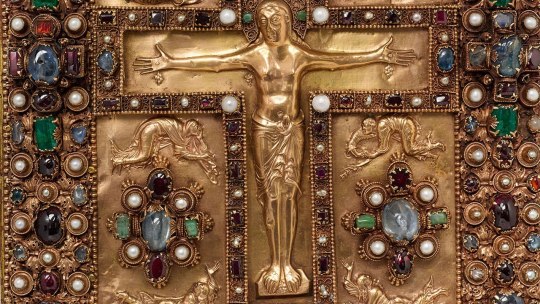
Unknown Crucifixion (Front cover of the Lindau Gospels) 870 Gold, precious stones, and pearls 1' 13/8" × 10 3/8" Saint Gall, Switzerland
A staple piece of Carolingian Art, this cover of the Lindau Gospels showcases the mix of Gallic, Germanic, and Roman art that has become its own unique style since the fall of the Roman empire. The serene posture of Christ, as well as the intricacies of all the figures & cloth showcases emphasizes the influence of Roman naturalistic art, whereas the inclusion of precious gems & abstract ornamentations showcases the influences of the Gauls and Germanic peoples who now make up the Carolingian Empire. In the modern day, this piece serves as a reminder of the relationship between art, devotion, and craftsmanship. It reflects the human desire to glorify beliefs through beauty and material excellence, a sentiment still evident in contemporary religious and cultural art.
0 notes
Text

Unknown Cross-Inscribed Carpet Page (Folio 26 verso of the Lindisfarne Gospels) 698–721 Tempera on vellum 1' 1 1/2" × 9 1/4" Northumbria, England
A beautiful example of Christianity's ability to blend with native cultures, this carpet page gives us a small glimpse into what is known as the Hiberno-Saxon art style, a mix of Anglo-Saxon & Celtic cultures/art which was prevalent in areas of what is now Northern England. Deeply intricate spiral shapes encased within geometric borders emphasize this unique style, as well as emphasizing the craftsmanship, meant to glorify God, the interconnected shapes blend together in many ways, which is often interpreted as representing the eternal nature of God. Today, this piece stands as a time capsule in a very interesting part of western history, where we can begin to see how modern English culture begins to take its roots, but well before the nation has become the global power which has influenced much of the world's cultures.
0 notes
Text

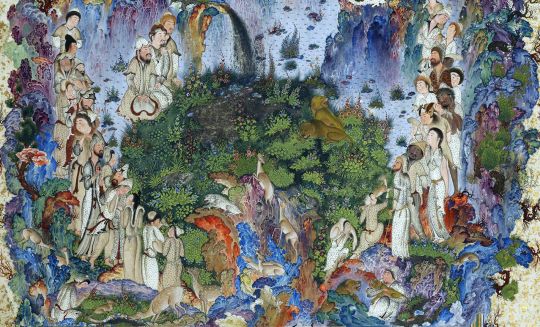
Sultan-Muhammad Court of Gayumars (Folio 20 verso of the Shahnama of Shah Tahmasp) 1525–1535 Ink, watercolor, and gold on paper 1' 1" × 9" Tabriz, Iran
A uniquely Persian piece in many ways, the Court of Gayumars displays a scene from Persian mythology, when Gayumars, the first king of humanity, held council in harmony with the natural world. Elevated on stone outcroppings, the king is surrounded by his court, all in intricate, flowing clothing that highlights the flora and fauna around them. It brings forward a utopian scene, where the human & natural worlds are balanced, and emphasizing the lost wisdom of the first king of mankind. To us today, it resonates heavily with our own conflict between the human & natural world, and calls up the ideals of stewardship of the land. It also brings forward a somewhat underlooked culture in modern western media, showcasing the rich history & mythology of the Iranian peoples.
3 notes
·
View notes
Text
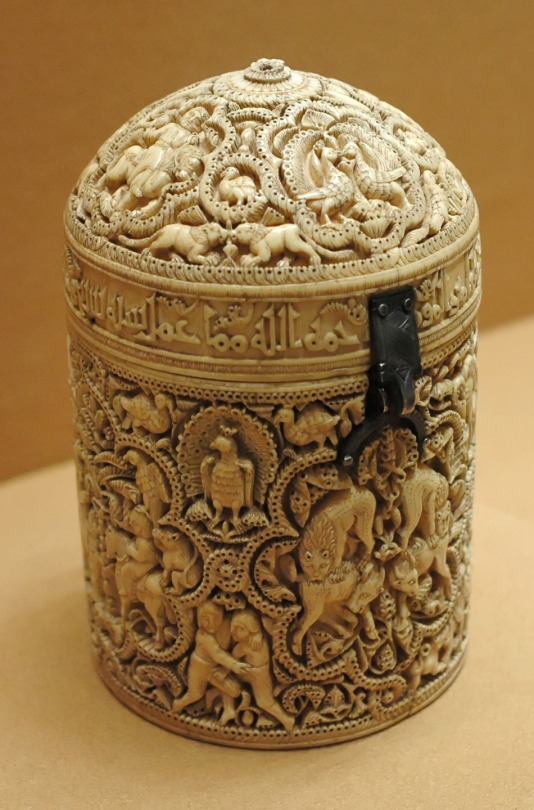
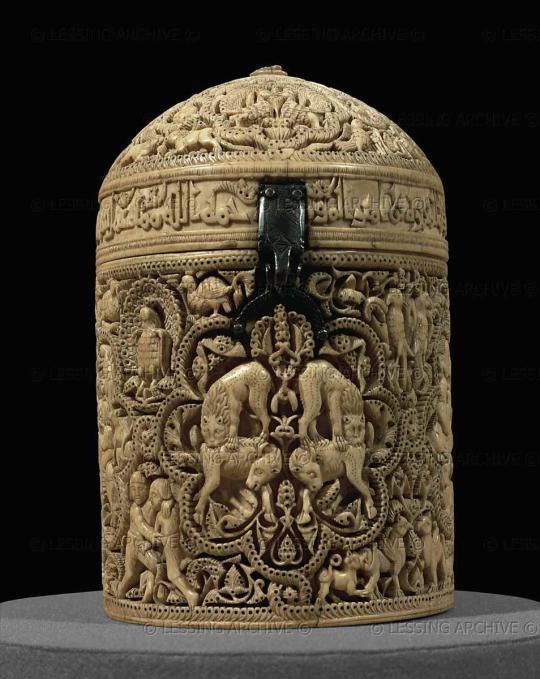
Unknown Pyxis of al-Mughira 968 Ivory 5 7/8" High Medina al-Zahra (near Córdoba), Spain
Crafted during the height of the Umayyad Caliphate in what is now Andalusia, Spain, this intricately carved ivory container was likely used to store cosmetics or perfumes of some sort. Portraying courtly life, princes, wild animals, and other figural representations, ideas which are curiously not commonly seen in Muslim art. This showcases the mixture of Iberian & Muslim motifs to create an intricate, unique piece of art. This piece greatly displays the history of different forms of art, and how cultures can become deeply intermixed over short periods of time. This piece is a deep expression of the people of the time, showcasing their developing cultures, but also showcasing political dominance over the region, a show of Islamic power over the Iberian peninsula as whole.
1 note
·
View note
Text
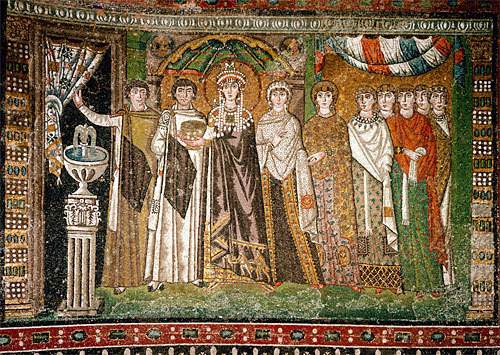
Unknown Theodora and Attendants 547 CE Mosaic 104" x 144" Basilica di San Vitale, Ravenna, Italy (South Wall of Apse)
Paired with the mosaic of Justinian on the northern portion of the apse, this mosaic of Theodora displays her surrounded by attendants in lavish clothes and a symbol of divine authority, but also she is presenting the chalice of the eucharist. We see an underlying power in the empress, and in fact in real history, Justinian's wife was one of his greatest advisers, a leader among the Monophysite Christians, a champion of legislative reforms, and key in Justinian keeping the throne during the Nika Revolt. Paired with Justinian's mosaic, we see nods to her true authority and power, something deeply overlooked in women throughout history, a good lesson we might all want to marinate on.
0 notes
Text
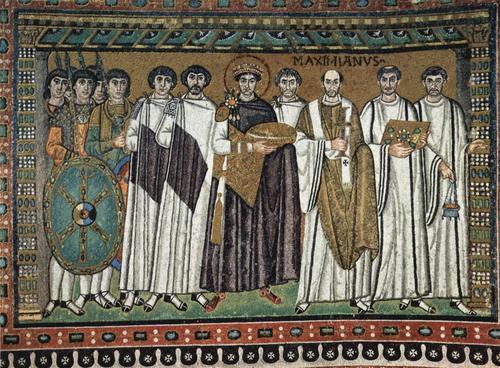
Unknown Justinian, Bishop Maximianus, and Attendants 547 CE Mosaic 104" x 144" Basilica di San Vitale, Ravenna, Italy (North Wall of Apse)
Another famous piece of Byzantine art, this mosaic of Emperor Justinian shows us the emperor, adorned with a halo and rich clothes, surrounded by the bishop, attendants, and guards of various kinds. We see that some things do not change throughout history, as one of the key themes is showcasing the emperor as divine, or in the case of Christians, divinely ordained to rule. This piece also shows the balance between religion & government, a duality which continues to define how many nations are run to this day. Unlike previous examples, we begin to see a Christian image of this form, as Justinian appears as a mediator, guiding the attendants of state and the bishop of the church together.
0 notes
Text

Unknown Christ as the Good Shepherd 425 CE Mosaic Approximately 6' x 6' Mausoleum of Galla Placidia, Ravenna, Italy
Famous throughout Christendom, Christ as the Good Shepherd is a very longlasting motif from earlier Christian artworks. Set among his flock, Jesus is shown in a serene pastoral setting, surrounded by sheep, adorned with a golden halo and lavish robes. Unlike what we have seen before in divine or semi-divine leaders, Christ as the Good Shepherd foregoes the balance between military might and diplomatic power, leaning instead into themes of caretaking and compassion. This symbol of leadership rooted in compassion and guidance is an image many have sought to emulate throughout the centuries of history.
0 notes
Text
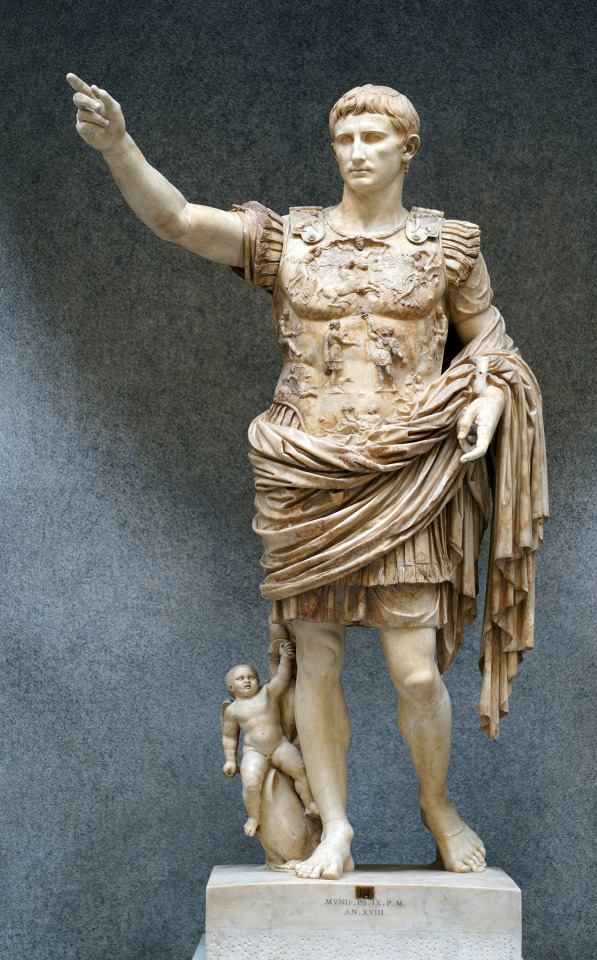
Unknown Portrait of Augustus as Imperator (General) Early 1st-century CE (copy of a bronze original from 20 BCE) Marble 6' 8" High Primaporta, Italy
While upon first glance, one can see the grandeur of this statue, there is also a lot of the story missing for those who are merely glancing at the piece. the Portrait of Augustus as Imperator is a central piece of Roman propaganda, showcasing the first emperor in a gentle, yet commanding light, wearing both the clothes of a general and an aristocrat. Cupid sits beside Augustus, a symbol of his divine heritage, and Augustus's armor is adorned with tales of his many military & diplomatic successes. While also a masterwork of art, we can see this resonate with many modern heads-of-state, utilizing their past achievements to elevate themselves to divine status, to use their image as a symbol for the people to rally around and to create a united national identity.
0 notes
Text
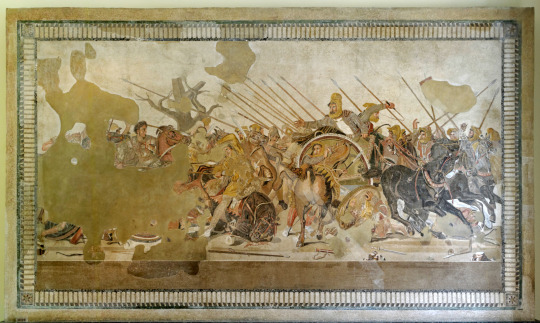
Philoxenos of Eretria Battle of Issus (Roman copy, known as the Alexander Mosaic) 2nd-1st Century BCE (modeled after painting from 310 BCE) Tessera mosaic 8' 10" × 16' 9" House of the Faun, Pompeii, Italy
While still damaged in many aspects, the Battle of Issus, or the Alexander Mosaic, portrays a dramatic battle between Alexander the Great and Darius III of Persia. While idealized in the mosaic, the piece gives a message of celebrating courage, strategy, and strong leadership. Leading his men against far great numbers, Alexander famously outmaneuvered the Persian army in many battles, and his victories are remembered even to this day. To us in the modern day, this piece resonates a sense of resilience, showing us the power of decisive and bold leadership, as well as the accomplishments they might bring.
0 notes
Text

Unknown Purse Cover from the Sutton Hoo Ship Burial 625 Gold, Glass, Enamel Cloisonné with Garnets and Emeralds 7 1/2” Long Sutton Hoo Ship Burial, Suffolk, England
This purse cover comes from the Sutton Hoo Ship Burial, a mysterious Anglo-Saxon burial site. Sutton Hoo gives us glimpses into the pre-Christian culture of England & the Germanic tribes of Europe. Believed to be the resting place of King Raedwald, the last pagan king in English history, the hoard from Sutton Hoo shows a very interesting image of Saxon England. The shapes showcased on the purse are distinctly Germanic, with round, swirling styles, the center figures are ravens, almost identical to similar finds from the Vendel Period and from Gothic burials all across Post-Roman Europe. However, the enamel work is distinctly Mediterranean, suggesting trade connections all across Dark Age Europe. Not only does this piece showcase royal power and Germanic artwork, it also shows trade & economy as essential to the peoples of the medieval world.
0 notes
Text
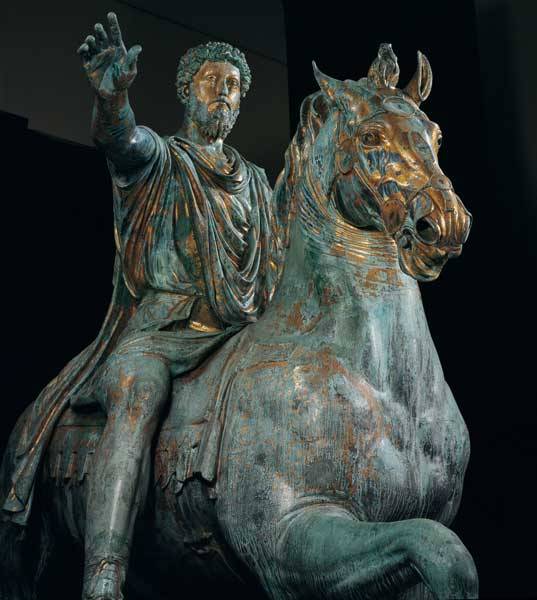
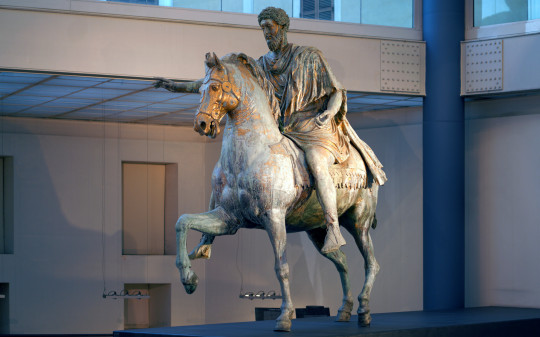
Unknown Equestrian Statue of Marcus Aurelius 175 CE Bronze 11' 6" High Rome, Italy
A grand symbol of imperial authority, the emperor Marcus Aurelius, who ruled the Roman Empire from 161 to 180 CE, is shown atop a horse, outstretching his hand in a way commonly seen in Roman Statues as ad locutio (military address to troops) or as a show of clemency. The horse itself represents imperial power, steered by the whims of the emperor. The statue symbolizes Marcus Aurelius as the great philosopher-king, embodying the ideals he preaches in his Stoic writings such as the Meditations. Statues were highly utilized by the Romans as propaganda, just like they are used today, and it is easy to see in this statue, the image of a strong head of state, holding both authority & magnanimity, guided by a deep-seated philosophy.
0 notes
Text
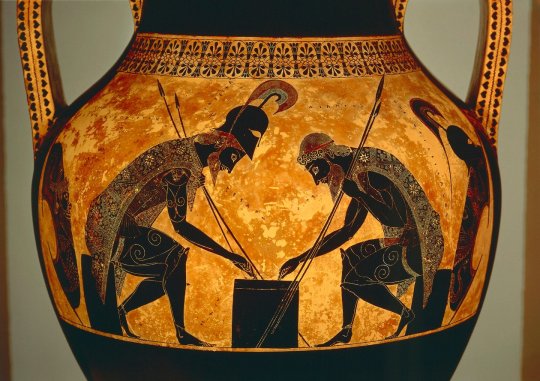
Exekias Achilles and Ajax Playing a Dice Game 540–530 BCE Terracotta, black-figure technique Amphora: 2' High; Detail: 8 1/2" High Vulci, Italy
This amphora is unique among many of its kind, foregoing great battles or funerals, and instead depicting the mythical, semi-divine heroes of Ajax & Achilles in a more mortal light, playing dice. The piece emphasizes the game the two are playing, dice, a reference to the Greek idea of moira, of fate or luck. Their power is emphasized through their helms, cloaks, and spears. Together, we form the image of the inexorability of fate or chance, that even these demi-gods are only human in many senses, and are subject to the whims of forces beyond them, and yet they choose to meet their fate, choosing to cast the dice themselves.
0 notes